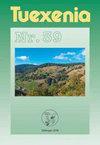喀尔巴阡盆地阴茅与假阴茅为主草原的比较研究
IF 1.1
4区 生物学
Q3 PLANT SCIENCES
引用次数: 7
摘要
本研究旨在揭示不同羊茅属、阴道羊茅属和假阴道羊茅属主导的开放沙质草地的物种组成和土壤性质的差异。由于干旱条件,沙质草原上普遍覆盖着干热植被,其中阴道草是典型的优势种。作者新描述的假阴道羊茅也可以在沙质草原上获得优势地位。然而,以该新发现物种为主的草原的物种组成和土壤性质仍未被发现。基于以往的群落学研究,我们假设以地方性阴道假单胞菌为特征的草原比以假阴道单胞菌为特征的草原物种丰富。2009年5月,在2 m × 2 m的样方上,采用布朗-布兰凯法对2个研究点进行了群落取样。在匈牙利中部的两个研究点,分别在阴道单胞菌和假阴道单胞菌占主导地位的林分取样5种相关变异,共取样20种相关变异。基于0-15 cm和15-30 cm土层维管植物种类和隐藓类结皮的覆盖评分以及pH [KCl]、pH [H2O]、腐殖质、全N、Ca、P2O5和K2O等7种土壤性质的测量值进行分析。采用线性混合模型,以“草地类型”为固定因子,“草地类型中嵌套的地点”为随机因子,比较假阴道草和阴道草为主的草地土壤性质(因变量)。数据分析采用聚类分析,融合算法采用组合方法(方差增加最小),相关性作为比较函数。采用Mann-Whitney U检验比较了隶属种的覆盖度。结果表明,假阴道假单胞菌与阴道假单胞菌具有较好的分离性,且假阴道假单胞菌优势草地的种数是阴道假单胞菌优势草地的近2倍。基于植物覆盖和0 ~ 15 cm土层数据的聚类分析,F. pseudovaginata论文于2016年12月12日收稿,2017年7月4日收稿。www.tuexenia.de;下载网址:www.zobodat.at本文章由计算机程序翻译,如有差异,请以英文原文为准。
Comparative study on grasslands dominated by Festuca vaginata and F-pseudovaginata in the Carpathian Basin
The aim of our study was to reveal the differences in the species composition and soil properties of open sandy grasslands dominated by different Festuca species, Festuca vaginata and F. pseudovaginata. Due to the arid conditions, sandy grasslands are generally covered by xerothermic vegetation in which F. vaginata is a typical dominant species. Festuca pseudovaginata, a species newly described by the authors, can also gain dominance in sandy grasslands. However, species composition and soil properties of grasslands dominated by this recently discovered species are still undiscovered. Based on previous coenological studies, we hypothesised that the grasslands characterised by the endemic F. vaginata are more species-rich than those with F. pseudovaginata. Coenological sampling was carried out in May 2009 at two study sites using the Braun-Blanquet method in quadrats of 2 m × 2 m. Five relevés were sampled in stands dominated by F. vaginata and F. pseudovaginata respectively at two study sites in Central Hungary, resulting in a total of twenty relevés. Analyses were based on the cover scores of vascular plant species and cryptogam crust and values of seven soil properties (pH [KCl], pH [H2O], humus, total N, Ca, P2O5 and K2O) measured in the 0–15 and 15–30 cm soil layers. Soil properties of the grasslands dominated by F. pseudovaginata and F. vaginata (dependent variables) were compared by linear mixed models, where ‘grassland type’ was the fixed factor and ‘site nested in grassland type’ was considered as random factor. Data were analysed by cluster analysis, fusion algorithm was a combinatorial method (minimising increase of variance), and the correlation was used as comparative function. We compared the cover of subordinate species by Mann-Whitney U test. We found that F. pseudovaginata and F. vaginata samples were well separated, and grasslands dominated by F. pseudovaginata had nearly two times more species than those dominated by F. vaginata. Based on the cluster analyses using plant cover and upper 0–15 cm soil layer data, F. pseudovaginata Manuscript received 12 December 2016, accepted 04 July 2017 Co-ordinating Editor: Balázs Deák ©Floristisch-soziologische Arbeitsgemeinschaft; www.tuexenia.de; download unter www.zobodat.at
求助全文
通过发布文献求助,成功后即可免费获取论文全文。
去求助
来源期刊

Tuexenia
PLANT SCIENCES-
CiteScore
2.80
自引率
25.00%
发文量
0
期刊介绍:
Tuexenia publiziert Original- und Übersichtsarbeiten sowie Berichte zu Themen der Geobotanik / Vegetationsökologie und zu Nachbarwissenschaften wie Populationsökologie, Biodiversitätsforschung, Biozönologie, Renaturierungsökologie und ihren Anwendungen, vor allem im Naturschutz. Der geografische Schwerpunkt liegt in Zentraleuropa und angrenzenden Regionen.Tuexenia erscheint jährlich in einem Band, der etwa zur Jahresmitte fertig gestellt wird. Autoren erhalten von jeder Arbeit eine PDF-Datei und gemeinsam 20 Sonderdrucke kostenlos.
Die Qualität der wissenschaftlichen Manuskripte wird durch die Redaktion und einen Wissenschaftlichen Beirat (Peer Review) gesichert (s. auch die Manuskript-Richtlinien vor dieser Seite). Es werden keine Druckkosten erhoben. Tuexenia legt Wert auf allgemeine Online-Verfügbarkeit der Beiträge.
 求助内容:
求助内容: 应助结果提醒方式:
应助结果提醒方式:


